At the core of commerce and industry, Bombay was the flashpoint of the five-year Samyukta Maharashtra movement resulting in the birth of Maharashtra on May 1, 1960. Stalwart sympathisers, dissenters speak of the struggle on its 60th anniversary
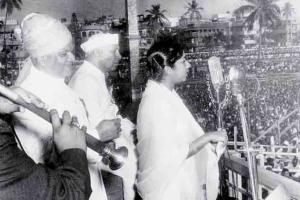
Addressing record crowds on May 1, 1960 at Shivaji Park, then PM Jawaharlal Nehru with music composer Vasant Desai and Lata Mangeshkar who sang the poet, saint Dnyaneshwar's verses for the occasion
 It was the best of times or the worst. Depending on the lens filtering standpoints on this agitation. In his memoir, Sentinel of the Sahyadris, ES Modak—Inspector General of Police, Maharashtra (1976-78), controlling crowds as DCP, Mumbai, in the 1955-56 outbreak of the Samyukta Maharashtra movement—calls the protests independent India's largest field riots.
It was the best of times or the worst. Depending on the lens filtering standpoints on this agitation. In his memoir, Sentinel of the Sahyadris, ES Modak—Inspector General of Police, Maharashtra (1976-78), controlling crowds as DCP, Mumbai, in the 1955-56 outbreak of the Samyukta Maharashtra movement—calls the protests independent India's largest field riots.
He hardly underestimated their impact. From slow simmers to conflagrations claiming over a hundred lives, frenzied clashes across town fulminated at Flora Fountain, now Hutatma Chowk, or Martyrs Square, honouring campaigners felled in the Battle for Bombay.
Modak remarked to his fiancee, earlier in 1942, "My life seems one long chase—after either dacoits or saboteurs." Years on, he handled the tumult to wrest Bombay for Marathi-speaking Maharashtra. As Deputy Commissioner during the fateful 1955-56 phase, he acted with Commissioner of Police KD Billimoria. The latter's daughter, Jeroo Mango, says, "At a function when he was CM, Sharad Pawar told me, 'A young man at the time, I can't forget your dynamic father braving it to Fountain in an open jeep.'"
Linguistic sub-nationalism combined with socialist ideals deepened and widened the democratic process, says Sandeep Pendse. His father Lalji Pendse, prominent in the Samyukta Maharashtra Samiti, was close to the Communist Party of India (CPI), though not a formal member. "Our Girgaon rented room was the unofficial local hub of the Samiti. Perhaps leftists saw the necessity of decentralised administration for the true benefits of 1947," he reasons.
The anti-Congress coalition involved a socialist majority, barring a few with reservations. Affiliations ranged from the CPI and Praja Socialist Party, to the Republican Party of India and the Marxists' Peasants and Workers Party. Steadily gaining ground as an uprising of plebs, the proletariat vs bourgeoisie schism paralleled a language issue, which asserted supremacy of their mother tongue.
Textile mills established by the British, enterprising Gujaratis and Parsi sethias sharply reshaped Bombay's demographic and socio-political contours. Wealthy mill magnates' employees came from the hinterland to power operations native fishermen settlers could not. Those villagers moved away from the weakening traditional balutedar system (balutedars were artisans providing upper castes services in exchange for food or land).
The migrant mazdoors were plunged in unrest on Bombay soil as well. Initially trying for a bilingual entity, Jawaharlal Nehru as PM then mooted Maharashtra and Gujarat as full-fledged states, with Bombay under the Centre's direct rule. Samyukta Maharashtra proponents rejected the plan. "According to them, the administrative language, playing a key role, had to be that of the people for democracy to be anything more than a word," explains Pendse. Congress was tackling two united adversaries, the communist and pro-Marathi factions.
The trigger was Nehru's All India Radio announcement of Bombay as "a separate city state" on November 20, 1955. Tensions peaked with firing the next day in Dadar, Lalbaug, Parel and Kalachowkie. On February 6, 1956, the Samyukta Maharashtra Chalavala demanded a carving of the Marathi-speaking state of Maharashtra with Bombay its capital.
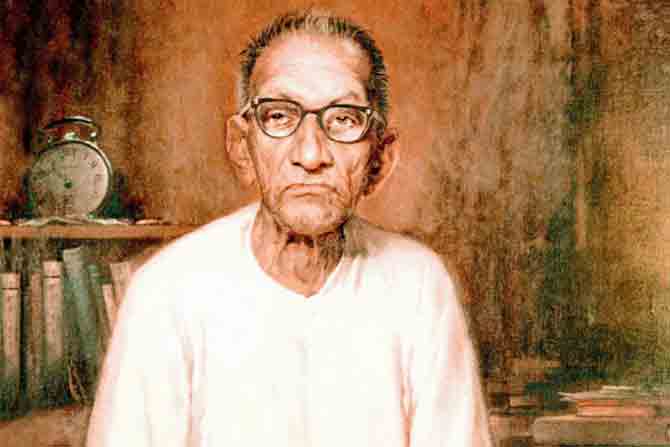
Painting of social reformer Prabhodankar Thackeray, who was active in the Samyukta Maharashtra movement, by SM Pandit. Picture courtesy/ Sena Bhavan
"The resistance protesters dealt with was from the ruling party and the government. I do not think masses of people attacked each other. The violence lay in confronting the state machinery, the clashes were between demonstrators and police forces," says Pendse.
On the other side, Indulal Yagnik dominated the Mahagujarat Andolan. Coined by writer-politician Kanaiyalal Munshi, the term Mahagujarat included all Gujarati-speaking areas, mainland Gujarat and peninsulas. Yagnik addressed public meetings supposed to pull in heftier numbers than Nehru's rallies on the same day. A schoolboy at the time, Kundan Vyas, editor-in-chief of the Janmabhoomi group of newspapers, witnessed mayhem in community strongholds like Bhuleshwar and Kalbadevi.
"Reports reached of a Gujarati exodus from Bombay Central in jam-packed trains," says Vyas. "Police firing at Fountain killed an accidental victim, the Janmabhoomi news editor just out for a stroll. Decades after, in 1977-78, during a debate in the Lok Sabha, I was on the Speaker-appointed committee and, in the press gallery, myself heard this statement from Morarji bhai—'Nehru asked me to call army vehicles to stop mob violence. I said 'No, they are our own people.'"
As a young Elphinstonian, collegians like activist Pushpa Bhave excitedly discovered themselves always on the scene because morchas terminated at Kala Ghoda. "SM Joshi and PK (Acharya) Atre were leaders who completely caught the public imagination. Strangely, for the first time since freedom, Nehru found no one behind him," she says. "It was about everyone coming together, labour, the middle class, leftists, even lumpen elements who made us uneasy. But I have seen wonderful things too. Like the policeman who could have been badly mauled, had SM Joshi not stood between him and the mob. That was truly a moment to cherish."
Filmmaker Jayprad Desai emphasises the event was a glaring example of people power shaking an empire. "Media has barely explored the movement. Turbulent times provide dynamic backdrops for stories." His web series, Hutatma, casts a girl, naive and apolitical, affected by an incident from the struggle that upturns her world to set her off on an extraordinary journey.
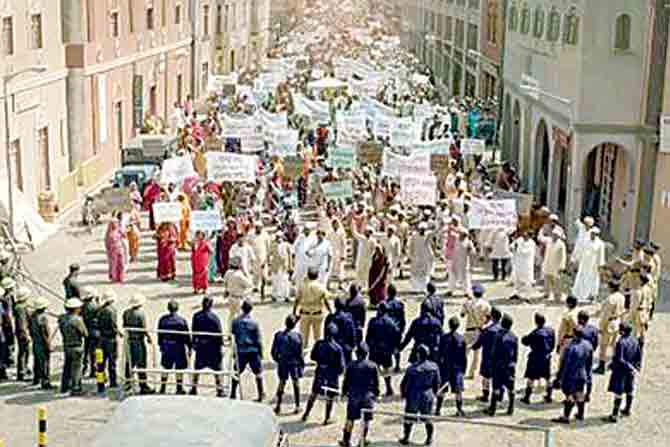
A still from the film Hutatma, showing the historic morchas starting from November 21, 1955, where demonstrators clashed with the police. Pic courtesy/ Jayprad Desai
"The huge Lalbaug-Parel mill district was fully zapped by fervour," Desai adds. "It was not about linguistic pride alone but the workers' daily bread. They feared that if Mumbai were handed over to non-Marathi capitalists, mill owners representing the establishment would totally control their destinies. So, they sought to assert the right to earn in their land, for their very existence. People today, especially youngsters, are not aware it was the first time almost the entire population of a state agitated against their government on the streets. The Samiti also took on the Congress by fair means, winning the 1957 elections."
Among those holding that more than Nehru it was really Sardar Patel who resisted the ceding of Bombay is Maharashtra CPI secretary, Prakash Reddy—"Led by SA Dange, the communists pre-empted the capitalist-backed Congress with their strike call in November 1955. Comrade Dange, Acharya Atre and SM Joshi were the pillars of Samyukta Maharashtra. Dange offered the idea of the might of workers, Atre's oratory destroyed Congress, Joshi gave us a moral base."
Like Pendse, Reddy inherits a robust legacy of principles from patriot parents who were in and out of jail throughout his childhood. His mother, Tara, once at the Quit India forefront, became Secretary of the Mahila Parishad wing canvassing for Samyukta Maharashtra and won the BMC 1957 election from Khetwadi, where the commune headquartered in 7th Lane. GL Reddy, his militant trade unionist father, diligently documented the struggle to preserve accounts of it.
Leftists maintain that Sena had little connect with the movement, the party itself launched six years after the state. However, Pandharinath Sawant, former editor of the weekly Marmik who considers Bal Thackeray's father his mentor, says, "I was the fortunate shishya of a reformer as great as Prabodhankar Thackeray. He was a Samiti member present at every meeting."
Panvel-born Keshav Sitaram Thackeray, the prolific author assumed the pen name Prabodhankar—from the fortnightly magazine he started, Prabodhan (Enlighten)—as his own. "Those at the forefront know many more lives were lost than official figures given," Sawant says.
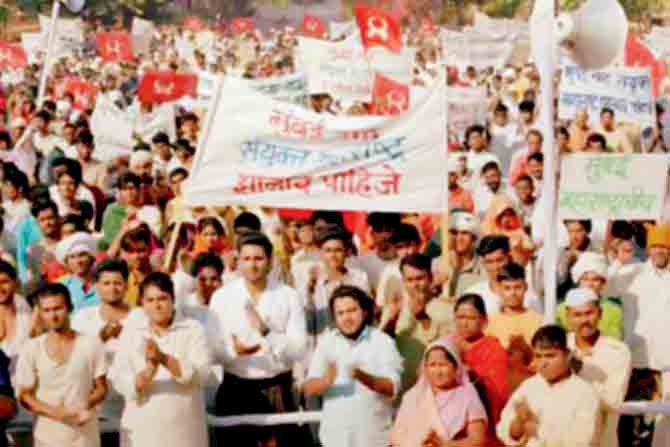
A still from the film Hutatma, showing the historic morchas starting from November 21, 1955, where demonstrators clashed with the police. Pic courtesy/ Jayprad Desai
Some Gujaratis seethed over the fact that news headlines often excluded losses they suffered. Pannalal Khimji Chheda narrates how cloth and grain merchants like his father were easy targets. Forcibly picked up from their small shops in Kalbadevi, Lalbaug, Parel and Dadar, they were subjected to "jhagra, tofaan aneh maar-faar (fighting, rioting and violence)". A schoolboy in Bordi, Chheda heard of the escalating turmoil and admits to being shocked at the polarised situation on his return.
Challenging the establishment threw up enough thinkers and intellectuals who published prodigiously and spoke vociferously. Strong influences were Acharya Atre with thought-provoking editorials and articles in his paper, Maratha, and scholar-critic Laxman Shastri Joshi. "I believe 1960 freely changed the surnames of authors and the milieu of literature," says Bhave. Revolutionary poet Shahir Amar Shaikh was an unbridled voice:
"Let us sing the hymns of Samyukta Maharashtra
With our heads held up, we hit the high notes…
The chronicles of history proclaim our pride.
For centuries, we have etched them in our own blood
Let us draw inspiration from those and unleash our strength.
Jai Maharashtra!"
Amar Shaikh had equally firebrand daughters in Malika, who married Dalit poet Namdeo Dhasal and Prerna, the progressive writer Anil Barve. Following their father's death, the sisters ensured that "Humanist" was registered in the space for religion—a first in the coroner's court.
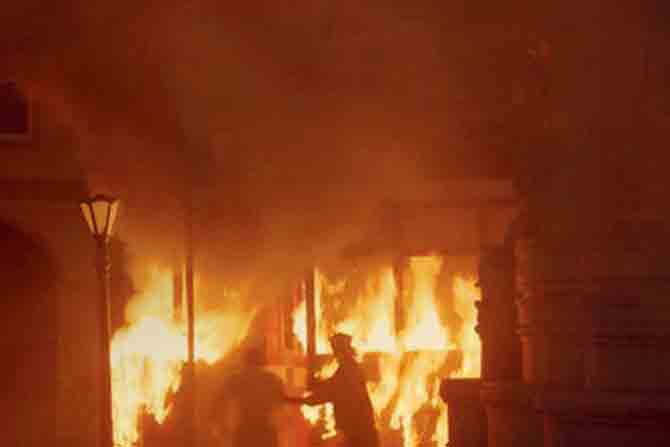
A still from the film Hutatma, showing the historic morchas starting from November 21, 1955, where demonstrators clashed with the police. Pic courtesy/ Jayprad Desai
Eventually, on May 1, 1960 (Labour Day), Yashwantrao Chavan was sworn in as freshly formed Maharashtra's first CM. Dr Jivraj Mehta assumed office likewise in Gujarat state. A balanced Kundan Vyas says, "Ultimately, after the states divided, the brotherhood spirit revived. The Gujarat Laxmi and Marathi Saraswati synergy brought prosperity to both."
Pendse concludes with caution: "The important lesson from the movement is to clearly understand identity politics. What seemed democratic and proto-socialist in the '50s—linguistic sub-nationalism—showed its ugly face of intolerant chauvinism and communalism merely a decade later."
Author-publisher Meher Marfatia writes fortnightly on everything that makes her love Mumbai and adore Bombay. Reach her at meher.marfatia@mid-day.com/www.mehermarfatia.com
Catch up on all the latest Mumbai news, crime news, current affairs, and a complete guide from food to things to do and events across Mumbai. Also download the new mid-day Android and iOS apps to get latest updates.
Mid-Day is now on Telegram. Click here to join our channel (@middayinfomedialtd) and stay updated with the latest news
 Subscribe today by clicking the link and stay updated with the latest news!" Click here!
Subscribe today by clicking the link and stay updated with the latest news!" Click here!









